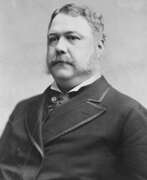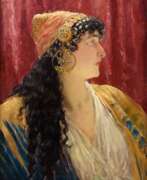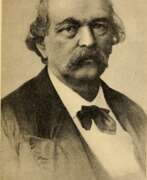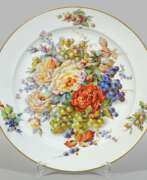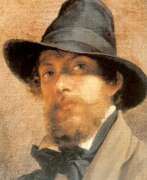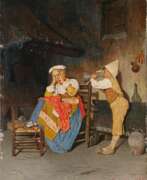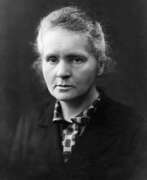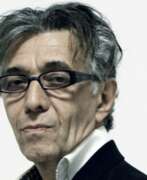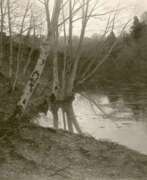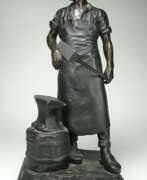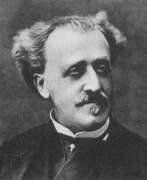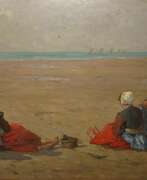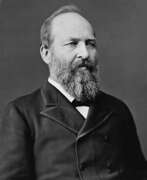Educators 19th century


Manuel Khristoforovich Alajalov (Russian: Мануил Христофорович Аладжалов) was a prominent Russian and Soviet landscape painter and educator, born in 1862 in Nakhichevan-on-Don. Alajalov's work is distinguished by his exquisite landscapes that capture the essence of the Russian countryside. His paintings are noted for their masterful use of light and shadow, bringing a serene and lifelike quality to his depictions of nature.
Alajalov's career was marked by a deep commitment to portraying the natural world with authenticity and emotion. His art reflects a profound appreciation for the tranquility and beauty of rural Russia, making him a significant figure in the history of Russian art. Alajalov's legacy as a teacher also influenced many aspiring artists of his time, further cementing his place in the artistic community.
Alajalov's works are showcased in several major Russian museums, including the State Tretyakov Gallery, where art enthusiasts can experience his contribution to landscape painting. His paintings continue to be celebrated for their technical excellence and emotional depth, attracting collectors and admirers from around the world.
For updates on new product sales and auction events related to Manuel Khristoforovich Alajalov, sign up for our newsletter. Stay informed about exclusive opportunities to own a piece of this celebrated artist's legacy.


Laure Albin-Guillot was a French artist and photographer. She is best known for her pioneering work in photography and for her contributions to the development of the medium in France during the early 20th century.
Albin-Guillot's early photographic work was focused on portraiture, and she became known for her elegant and striking images of celebrities and other notable figures. She later expanded her practice to include still life and landscape photography, and she was also a skilled photojournalist.
In addition to her photography, Albin-Guillot was an important figure in the Parisian art world, and she was involved in the development of modernist movements such as Cubism and Surrealism. She was a member of the Société des Artistes Décorateurs and was also involved in the organization of several major international exhibitions, including the Exposition Internationale des Arts Décoratifs et Industriels Modernes in Paris in 1925.
Albin-Guillot was also a prolific writer and educator, and she wrote several books on photography and art history. She taught photography at the École Estienne in Paris, and she also founded her own photography studio, which became known for its innovative use of lighting and composition.
Today, Albin-Guillot's work is recognized as an important contribution to the development of modern photography, and her photographs are held in the collections of major museums around the world, including the Museum of Modern Art in New York, the Centre Pompidou in Paris, and the Victoria and Albert Museum in London.


Antonio Ambrogio Alcati was an Italian academic painter, portraitist, master of frescoes and teacher. He studied painting at the Vercelli Institute of Fine Arts and the Brera Academy of Fine Arts.
Ambrogio Alcati's work is also influenced by Impressionism.


Ivan Petrovich Argunov (Russian: Иван Петрович Аргунов) was a distinguished Russian painter of the 18th century, celebrated for his significant contribution to portrait art. As a serf born into the Argunov family, who were established artists themselves, Ivan's talent was nurtured and supported by his patrons, leading to a unique position within the cultural and artistic hierarchies of his time. His specialization in portraiture allowed him to capture the essence of Russia's social elites, including members of the imperial family, as well as ordinary Russians, thereby providing a wide-ranging visual documentation of the era's societal strata.
Argunov's art is noted for its meticulous attention to detail, vibrant realism, and the emotional depth he brought to his subjects. His portraits are more than mere representations; they are intimate glimpses into the lives and characters of his sitters. Among his most famous works is the portrait of Princess Natalia Petrovna Golitsyna, showcased in the Tretyakov Gallery in Moscow. This particular piece stands out for its intricate portrayal of fabric textures and the detailed rendering of facial expressions, which have been lauded for their lifelike quality and depth.
Argunov's legacy extends beyond his artistic achievements; he played a pivotal role in shaping the course of Russian portraiture. His works are preserved in major museums and galleries across Russia, serving as a testament to his skill and the cultural richness of his time. For collectors and experts in art and antiques, Argunov's paintings are not just historical artifacts but are cherished for their aesthetic value and the insight they offer into 18th-century Russian culture.
We invite enthusiasts and collectors to stay connected with us for updates on new product sales and auction events related to Ivan Petrovich Argunov. By signing up, you will gain exclusive access to the finest pieces of Russian art and antiques, ensuring you never miss an opportunity to enrich your collection with works by one of Russia's most esteemed artists.


Charles Baker was a British educator, pioneer in deaf education, naturalist and artist.
He became known and honored in Great Britain for having developed the first school textbooks for deaf-blind children, including those based on drawing.
As a young man he became a teacher at the Edgbaston Institute for the Deaf and Dumb in Edgbaston, near Birmingham, and was faced with a complete lack of textbooks for such children. Baker had a passion for entomology, and began directing the attention of his older pupils to the various objects of natural history around them. As a result, in 1828, he authored a small volume of illustrations entitled British Butterflies: their differences, genera and species, with lithographic illustrations of each genus, comprising 33 species, drawn by the children of the Edgbaston School for the Deaf and Dumb."
Charles Baker worked as a teacher of the deaf and headmaster at Doncaster School for forty-five years. During this time he produced many specialized teaching guides and textbooks under the general title "Circle of Knowledge", which were used in Europe and Russia, as well as in China and Japan.


Hendrikus van de Sande Bakhuyzen was a Dutch landscape painter and teacher.
Bakhuyzen studied at The Hague Academy of Art. He is known for his romantic pastoral scenes, especially paintings of livestock, with detailed landscapes.
In 1822 he became a member of the Royal Academy of Arts in Amsterdam and a member of the board of the Academy of Arts in The Hague. He was later elected director of the Hague Academy. Hendrikus Bakhuyzen made a significant contribution to the Romantic period in Dutch art through his work and activities, raising many talented students and followers who founded the artistic movement known as the Hague School.
His children were also very talented: son Julius van de Sande Bakhuyzen (1835-1925) became a renowned landscape painter; daughter Gerardine Jacob van de Sande Bakhuyzen (1826-1895) became a still life painter; son Henrik Gerard van de Sande Bakhuyzen (1838-1923) became a prominent astronomer, member of the Royal Netherlands Academy of Arts and Sciences and director of the Leiden Observatory; son Ernest-Fredrich van de Sande Bakhuyzen was also an astronomer at the Leiden Observatory.


Vasily Nikolayevich Baksheyev (Russian: Василий Николаевич Бакшеев) was a distinguished Russian painter, celebrated for his contributions to landscape, interior, still life, and genre painting. His works are emblematic of the Union of Russian Artists' spirit, a movement he was closely aligned with throughout his career. Born in Moscow in 1862, Baksheyev was a prodigious talent who honed his craft at the esteemed Moscow School of Painting, Sculpture, and Architecture from 1877 to 1888, under the tutelage of luminaries such as Vladimir Makovsky, A. K. Savrasov, and V. D. Polenov. His artistic journey was marked by a significant award early on—a large silver medal for "The Return of Pilgrimage" in 1889—and travels to cultural hubs like Paris and Munich in 1895, which broadened his artistic horizons.
Baksheyev's artistry evolved over the years, from initial genre pictures to a profound exploration of landscape painting, for which he is most renowned. His works, especially from the Soviet era, continue the rich tradition of Russian lyrical landscape, imbued with a poetic quality that captures the essence of nature's transient beauty. His teaching career and efforts in organizing regional museums further underscore his commitment to art and community. Baksheyev's legacy is preserved in his poignant and luminous paintings, such as "Twilight," "Birches," and "Sunny Day," which offer a glimpse into the serene and vibrant landscapes of the Tarusa region. His work remains an invaluable part of Russia's cultural heritage, housed in numerous museums across the country and celebrated for its artistic integrity and emotional depth.
For art collectors and enthusiasts, Baksheyev's oeuvre represents a pivotal chapter in the evolution of Russian painting, characterized by its lyrical beauty and emotive power. His ability to blend impressionistic brushwork with symbolic imagery creates a unique visual language that speaks to the heart of the Russian landscape tradition.
To stay updated on new insights and opportunities related to Vasily Nikolayevich Baksheyev, including sales and auction events, signing up for updates is highly recommended. This subscription ensures that enthusiasts and collectors alike are always informed about the latest developments and available works related to this exceptional artist.


Sabine Baring-Gould was a Victorian British clergyman, poet, writer and folklorist.
He traveled extensively in Europe, studied at Clare College, Cambridge, was ordained in the Church of England in 1864, and was appointed vicar at Horbury. Baring-Gould was a polyglot and knew six languages. Despite his ministry, he had a serious interest in supernatural phenomena and in 1865 published a book called The Book of Werewolves.
In addition to this, Baring-Gould was interested in a wide range of subjects. His work is diverse and covered theology, history, poetry, hymns, fiction, biography, travel, social commentary, and folklore. Baring-Gould collected the folk songs of old English singers, personally visiting them and recording the words and music. In 1889 he published a collection of Songs of the West in four parts, of which he was proud, and also wrote several patriotic hymns.
Baring-Gould was a very prolific writer: during his life he wrote many novels, published short stories in periodicals, the popular "Curious Myths of the Middle Ages," and others, his bibliography numbering some 1,250 works.


Harriet Beecher Stowe, full name Harriet Elisabeth Beecher Stowe, was an American writer and poet, an activist for the eradication of slavery in the country.
Beecher Stowe is the author of the world-famous novel Uncle Tom's Cabin. Published first in a newspaper and first published as a book in 1852, it aroused widespread anger in the country and galvanized the fight against slavery in the southern United States. This novel was later reprinted many times in all languages of the world and has been screened more than once.
In her youth, Beecher Stowe received an academic education, wrote poetry, notes and essays on social topics. In addition to "The Shack", she wrote several other novels and was engaged in teaching.


Hiob Carl Oscar Begas was a German painter of the mid-nineteenth century. He is known as a portraitist, landscape painter, historian, teacher, son of the painter Carl Begas, brother of the sculptors and painters Carl, Rheingold and Adalbert Begas.
Oscar Begas was the author of portraits of many prominent German and foreign statesmen and military figures, representatives of science and culture. Becoming a popular painter, he received many orders from King Friedrich Wilhelm IV of Prussia. According to critics, more than in commissioned portraits, Begas's painterly skill was demonstrated in his atmospheric winter and autumn landscapes, on which the master concentrated towards the end of his life.


Pavel Petrovich Benkov (Russian: Павел Петрович Беньков) was a Russian and Soviet artist of the first half of the twentieth century. He is known as a painter, graphic artist, theater decorator, and teacher.
Pavel Benkov created portraits, landscapes, cityscapes, genre paintings. His style in his mature years can be described as impressionist, with attention to color and light. In 1929 he moved to Central Asia, where his style took on unique characteristics, reflecting local landscapes and culture. His work has had a significant influence on the painting traditions of Uzbekistan and Central Asia.
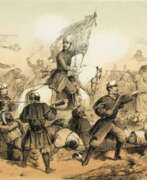

Bernardo Blanco y Pérez was a Spanish lithographer, painter and illustrator.
He studied at the Royal Academy of San Fernando, mainly drawing and lithography, and taught. Bernardo Blanco was one of the artists whose work was included in a series of lithographs on the Spanish-Moroccan War (1859-1860).


Jan Bleuland was a Dutch physician, medical scientist, educator and writer.
Bleuland was an intellectually advanced man, a sought-after physician, and a rich lover of the arts. Jan Bleuland taught anatomy, physiology and obstetrics for 31 years and was professor and rector of Utrecht University. His talents as a physician and medical researcher were recognized not only by his patients and the scientific community, but also by the highest authorities.
During his lifetime, Jan Bleuland amassed a large collection of medical specimens of the human body, which he used for research. Part of this significant collection is still on display in the original wooden Bleulandkabinet in the Utrecht University Museum. The Bleulandkabinet contains an extensive collection of skeletons, embryos in alcohol and wax preparations of body parts. His pioneering preparations were acquired by Utrecht University by royal decree of King Willem I in 1815 and are still used as teaching material.
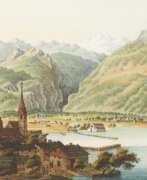

Johann Heinrich Bleuler the Elder was a Swiss landscape painter and engraver.
Bleuler the Elder first trained as a porcelain painter at the Kilchberg-Schooren porcelain manufactory near Zurich. In the early 1780s he settled in Feuertalen and became the founder of the dynasty of artists that is known as the "Bleulerische Malschule". His two sons, Johann Heinrich Bleuler the Younger (1787-1857) and Johann Ludwig Bleuler (1792-1850), also became artists and continued their father's work. And in total, there were up to 25 artists in the dynasty, including godchildren and other relatives.
Bleuler the Elder created mainly landscapes of the Rhine, painted in gouache and watercolor, panoramic views of Swiss cities. He also worked as an art teacher.


Yulii Yulyevich Blumenthal (Russian: Юлий Юльевич Блюменталь) was a Russian and Soviet artist of the first half of the twentieth century of German origin. He is known as a painter and graphic artist who played an important role in the development of Bashkir fine arts.
Yulii Blumenthal created portraits, landscapes and genre works, including those reflecting the culture and life of the Bashkir people, such as "Bashkir Rider" and "Behind Shearing Sheep". Being the director of the Bashkir State Art Museum in 1926-1935, the master played a significant role in laying the foundations of professional museum accounting and documentation.


Grigory Mikhailovich Bobrovsky (Russian: Григорий Михайлович Бобровский) was a distinguished Russian painter born in Vitebsk in 1873 and passed away in Leningrad in 1942. His academic journey in the arts began at the prestigious Academy of Arts under the tutelage of Ilya Repin between 1893 and 1900, where he honed his craft and graduated with the title of artist for his painting "Evening." By 1916, Bobrovsky was recognized as an academician, contributing significantly to the Russian art scene with his evocative landscapes and scenes capturing early 20th-century life.
Bobrovsky's artwork is celebrated for its free manner of painting, decorative expressiveness of color, attention to lighting effects, and the fragmentariness of composition. His works, which were influenced by both the Union of Russian Artists and the Mir Iskusstva movement, spanned a variety of themes, including landscapes and scenes dedicated to the Revolution and life in the USSR. Notable works include "Early Spring" (1922), "Night at Sea" (1923), and "The Road" (1927), showcasing his mastery over light and color.
His contributions to Russian art were recognized through exhibitions during his lifetime and posthumously, with retrospective exhibitions held in Leningrad (1947) and Perm (2001). Bobrovsky's works are part of several prestigious collections, including the State Tretyakov Gallery, the State Russian Museum, and the Perm State Art Gallery, evidencing his lasting impact on the art world.
For art collectors and experts, Grigory Mikhailovich Bobrovsky's oeuvre offers a profound insight into the evolution of Russian painting in the early 20th century. His ability to capture the essence of his era through vibrant colors and expressive compositions makes his work a valuable addition to any collection.
To stay updated on new product sales and auction events related to Grigory Mikhailovich Bobrovsky's works, sign up for updates. This subscription will keep you informed about opportunities to acquire pieces by this remarkable artist, ensuring you don't miss out on adding a piece of Russian art history to your collection.


Joseph Georg Böhm was an Austrian astronomer, astrophysicist, cartographer, mathematician, and educator.
At the University of Prague, Böhm attended lectures in mathematics, physics, astronomy, and, after receiving his doctorate, became an assistant at the Vienna Observatory under Joseph Johann von Littrow. He then worked at the observatory at Othen and taught mathematics at the University of Salzburg. In 1839 he was appointed professor of mathematics and practical geometry at the University of Innsbruck, and in 1848 he was elected its rector. In 1852 Böhm was appointed director of the Prague Observatory and professor of theoretical and practical astronomy at the University of Prague.
Georg Böhm published several significant astronomical papers on solar observation. He is the creator of several instruments for astronomical measurements and observations, and he designed the Uranoscope and Universal Gnomon for amateur astronomical observations for the general public. As a member of the commission for the repair of the Prague Astronomical Clock, which he joined in 1865, he wrote a detailed description of it in the work Beschreibung der alterthümlichen Prager Rathausuhr. In addition to astronomy and its popularization, he was also involved in agriculture, economics, and geodesy. One of his important works is Ballistic Experiments (1865).


Matthieu Bonafous was a prominent French botanist and agronomist.
Bonafous was an innovator in 19th century agronomy, specializing in technical farming, with a particular interest in corn and its economic importance as a food crop. He also studied mulberry trees and created new species for silkworm breeding, and wrote many scientific articles, including one on rice.
As a teacher, Matthieu Bonafous offered a traveling course based on direct contact with practitioners of scientific farming.


Désiré-Magloire Bourneville was a French physician, neurologist, innovator and educator, and statesman.
Born into a modest family, Bourneville began his medical education in 1860 and for about ten years worked as an assistant to Jean-Martin Charcot, where, together with Paul Régnard, he supervised the publication of "Photographic Iconography of Salpetriere". During the Franco-Prussian War, he served as both surgeon and physician's assistant. Appointed physician at Bissetre, Borneville devoted himself to the medical and educational care of "idiots and epileptics" for whom he organized a service, and later directed the Fondation Vallée in Gentilly until his death. He is considered one of the earliest child psychiatrists.
In 1876, Bourneville was elected a municipal councilor of Paris, three years later he became a general councilor of the Seine, and then a deputy. In this capacity, Bourneville carried out several health reforms: he became the rapporteur for the public assistance budget and the budget for psychiatric asylums, achieved the creation of the first special classes for mentally retarded children, and the first municipal nursing school in Salpêtrière.
Bourneville had many very different talents. Very early on he became interested in medical journalism, where he made a name for himself through the vividness of his articles. In 1873, he founded the journal Progrès Médical, which promoted the tenets of avant-garde medicine, open to pioneering scientific developments (Bourneville published Charcot's lessons) and social issues. He fully developed the theoretical and practical foundations of teaching for the nursing profession. Outraged by the lack of practitioners' professional knowledge of obstetrics, he worked to create a new medical specialty, gynecology. But his main purpose in life was to educate and nurture those who were labeled "idiots" and mentally retarded.
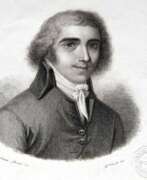

Giovanni Battista Brocchi was an Italian mineralogist, geologist and paleontologist.
Brocchi studied law at the University of Padua, but was seriously interested in natural sciences and mineralogy. In 1802, Brocchi became a teacher of natural history at the Brescia Gymnasium. Appointment in 1808 as inspector of mines in Milan gave him the opportunity to travel extensively in Italy, making extensive notes and collecting numerous samples. The fruits of these labors appeared in various publications, notably his "Treatise mineralogical and chemical on the iron mines of the department of Mella" (1808). He then obtained a position as inspector of mining in the newly created kingdom of Italy.
In 1811 Brocchi wrote a valuable essay entitled "Mineralogical Memoirs on the Fassa Valley in the Tyrol." He made his first extensive exploration of central Italy in 1811-1812, witnessed the eruption of Vesuvius, and was able to compare the condition of its crater before and after the eruption. But his most important work is Fossils of the Sub-Apennines with geological observations on the Apennines and adjacent soil (1814), which contains precise details of the structure of the Apennine ridge and an account of the fossilization of Italian Tertiary strata in comparison with existing species. Brocchi also wrote several significant works on biology.
In the fall of 1822 he sailed from Trieste to Egypt, whence he made excursions up the Nile and into Syria and Palestine. In 1826 he contracted the bubonic plague, of which he died. His last journals and collections are preserved at the Museo Civico in Bassano. In all, Brocchi published five voluminous books and about seventy articles in various journals.
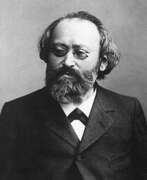

Max Bruch, full name Max Christian Friedrich Bruch, was a German composer and conductor, violinist and teacher of the late Romantic period.
Bruch studied with the composer and pianist Ferdinand Hiller (1853-1857), wrote a symphony at age 14, and won a scholarship that allowed him to study in Cologne. His first opera, Joke, Deceit and Revenge, was performed in 1858. He conducted orchestral and choral societies in Germany, England and Poland, and from 1890 to 1911 he was a professor at the Berlin Academy of Arts.
Bruch was an ambitious and prolific composer. His greatest success during his lifetime was his huge works for chorus and orchestra, Beautiful Ellen (1867) and Odysseus (1872). He was also the author of string concertos and pieces for violin and orchestra. His Violin Concerto No. 1 in G minor (1866) is one of the most popular Romantic violin concertos.
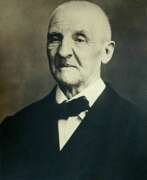

Anton Bruckner, full name Joseph Anton Bruckner, was an Austrian composer, organist and music educator.
Bruckner was born into a poor family, which prevented him from receiving an education suited to his musical talent. His father taught him to play the violin and organ, and he worked as a teacher and organist for many years. Already after the age of 30, he began composing organ and choral works, including the Solemn Mass (1854). In 1855 he became organist at Linz Cathedral and took a five-year course in harmony and counterpoint with the Viennese teacher Simon Sechter. A little later Bruckner studied orchestration with Otto Kitzler, who in 1863 introduced him to the music of Wagner - a powerful impetus for him to begin composing significant compositions.
After moving to Vienna in 1686, Bruckner taught at the Conservatory and the University of Vienna and composed at the same time. Over the next 28 years he wrote most of his famous works: symphonies Nos. 2-9, a string quintet and the Te Deum. But it was not until the premiere of his Seventh Symphony in Leipzig in 1884 that he received the recognition he deserved. Until his death, he continued to compose new works and rework his earlier works.
Anton Bruckner was an outstanding virtuoso organist and a superb teacher. His symphonies are often considered symbolic of the final phase of Austro-German Romanticism, and he also composed much sacred secular choral music and chamber works.


Ferdinand Brütt, full name Ferdinand Martin Cordt Brütt, was a German Impressionist painter.
Brütt began his studies at the Hamburg School of Applied Arts, then continued at the Art School of the Grand Duke of Saxony in Weimar before embarking on an extended study trip to Italy. For many years he lived in the Kronberg artists' colony in Kronberg im Taunus.
Brütt painted more often scenes from public places, particularly court sessions, domestic genre subjects and landscapes. From 1906 to 1913 he created several large wall and ceiling murals for the city of Frankfurt. In 1905 he was commissioned to design a large public hall in the town hall of Frankfurt am Main.
Ferdinand Brütt also taught at the Academy of Arts Düsseldorf, was a member of the Association of German Artists and was a member of the Association of Artists of Malkasten.


Fyodor Fyodorovich Buchholz (Russian: Фёдор Фёдорович Бухгольц) was a Russian artist of German origin in the late 19th century and the first half of the 20th century. He is known as a painter, graphic artist and teacher.
Fyodor Buchholz painted mainly on historical themes and genre paintings, as well as portraits and landscapes. At the end of the XIX century, the artist was fascinated by Art Nouveau. After the revolution of 1917 he began to create works on the themes of social construction.


Joseph-Casimir Konstantinovich Budkevich (Russian: Иосиф-Казимир Константинович Будкевич) was a Ukrainian painter and draftsman, born on April 18, 1841, in Kyiv. Known for his battle scenes and landscapes, Budkevich studied at the Imperial Academy of Arts in Saint Petersburg, where he received several medals for his works. In 1873, he was awarded the title of Class Artist 3rd Degree.
Budkevich traveled to Italy, France, Spain, and Palestine to refine his skills. In the late 1870s and 1880s, he taught at the Kyiv Drawing School, where one of his students was Mykola Pymonenko. From 1887 to 1895, he was a member of the Kyiv Society of Art Exhibitions.
Among his notable works are "Pilgrim at the Monastery Wall" (1883) and "Jerusalem" (1894). These paintings are exhibited at the Kyiv Museum of Russian Art and the Pskov Art Gallery. His work is highly valued by collectors and art experts for its uniqueness and mastery.
If you want to receive notifications about new arrivals and auctions related to Joseph-Casimir Budkevich's work, subscribe to our updates. We will keep you informed about new sales and events related to his legacy.


Victor Yakovlevich Bunyakovsky (Russian: Ви́ктор Я́ковлевич Буняко́вский) was a Russian mathematician, teacher, historian of mathematics, vice-president of the Academy of Sciences in 1864-1889. He made a significant contribution to number theory.


Georg Burmester was a German artist of the late 19th - first third of the 20th centuries. He is known as a painter, graphic artist, impressionist, representative of the Düsseldorf art school, and teacher.
Burmester worked mainly in the genres of landscape and marinas, but among his works there are also still lifes, as well as works in the genre of nude. He was a teacher at the Kassel Art School from 1912 to 1930 and was promoted to the rank of professor in 1917.


Eugène Burnouf was a French Orientalist scholar, linguist, and researcher of Buddhism in the mid-19th century.
Burnouf studied at the School of Law and the Collège de France. In collaboration with the Norwegian orientalist Christian Lassen, he published Essai sur le Pali (1826) in one of the languages of Indian Buddhism. He then undertook the decipherment of Zoroastrian manuscripts.
As professor of Sanskrit at the Collège de France (1832-1852), Burnouf made a significant contribution to the study of Zoroastrianism. He also made a Sanskrit edition and French translation of the important Hindu text Le Bhâgavata Purana (1840) and published a history of Buddhism (1845).


Louis Gustave Cambier is a Belgian painter-painter and sculptor, member of the Royal Academy of Fine Arts in Brussels.
Cambier studied at the Royal Academy of Fine Arts in Brussels and was a co-founder of the Brussels artists' group Le Labeur. During the First World War, he worked as a professor of sculpture at the Académie de Nice and one of his students was Henri Matisse.
Cambier painted landscapes, still lifes and genre scenes, as well as portraits of famous contemporaries, including, for example, a portrait of Winston Churchill.


Michele Cammarano was an Italian realist painter. He is the author of numerous paintings in the battle genre. He studied painting at the Academy of Fine Arts in Naples.
In March 1870, during a trip to Paris, the artist met Gustave Courbet, whose work was close to his own views on art.


Karl Caspar was a German painter and graphic artist.
Caspar studied at the Art Academy in Stuttgart and the Academy of Fine Arts in Munich. In 1904 he became a member of the Stuttgart Artists' Union (Stuttgarter Künstlerbund), in 1906 he joined the German Artists' Union (Deutscher Künstlerbund). In 1913 he became one of the founders of the New Munich Secession, becoming its chairman in 1919.
Karl Caspar's creative field was painting and drawing with Impressionist and Expressionist influences in various genres, from Christian subjects to the nude genre.
From 1922 to 1937, Karl Caspar was professor and then president of the Academy of Fine Arts in Munich. In 1937, his works were exhibited at the Exhibition of Degenerate Art organized by the Nazis in Munich, but many of them were then withdrawn from German museums and state collections and destroyed. After the end of World War II, Karl Caspar returned to teaching: in 1948 he became one of the founders of the Bavarian Academy of Fine Arts, and in 1955 he became an academician of the Berlin Academy of Arts. He participated in the Venice Biennale and was awarded the Order of Merit of the Federal Republic of Germany in 1950.


Augustin Louis Cauchy was a French mathematician and mechanic, military engineer, and founder of mathematical analysis.
Cauchy studied at the École Polytechnique and at the Paris School of Bridges and Roads. After becoming a military engineer, he went to Cherbourg in 1810 to work on harbors and fortifications for Napoleon's English invasion. Here he began independent mathematical research. Cauchy returned to Paris in 1813, and Lagrange and Laplace convinced him to devote himself entirely to mathematics. The following year he published a memoir on definite integrals, which formed the basis of the theory of complex functions. From 1816, Cauchy held professorships at the Faculty of Natural Sciences, the Collège de France, and the École Polytechnique in Paris.
Cauchy developed the foundation of mathematical analysis, and made enormous contributions to analysis, algebra, mathematical physics, and many other areas of mathematics. He almost single-handedly founded the theory of functions of a complex variable, which has extensive applications in physics. Cauchy's greatest contributions to mathematics are published primarily in three of his treatises, "Courses in Analysis at the Royal Polytechnic School" (1821), "Summary of Lessons on Infinitesimal Calculus" (1823), and "Lessons on the Application of Infinitesimal Values in Geometry" (1826-28). In all, Augustin Louis Cauchy wrote about 800 scientific articles.
Cauchy was a member of the Paris Academy of Sciences, the Royal Society of London, the St. Petersburg Academy of Sciences, and other academies.


Petr Ilich Chaikovskii (Russian: Петр Ильич Чайковский) was a great Russian composer, teacher, conductor and music critic.
Petr was born into the family of a mining engineer; later his father became manager of the Alapaev and Nizhnekamsk factories and director of the Technological Institute in St. Petersburg. Already at the age of five Peter began to learn to play the piano and compose. Educated as a lawyer, he was appointed to the Ministry of Justice and retired in 1867.
In 1865, Chaikovskii graduated with honors from the St. Petersburg Conservatory, composing several significant works during his years of study. From 1866-1878, Chaikovskii was a professor at the Moscow Conservatory, translated several musical-theoretical works, and wrote A Guide to the Practical Study of Harmony. In 1868 he made his first appearance in the press as a music critic, and later worked as a music reviewer for the Moscow newspapers Sovremennaya Annals and Russkiye Vedomosti.
Petr Ilich destroyed his first operas - "Voevoda" and "Undina" - apparently dissatisfied with the result, but his next concertos and symphonies, the operas "Oprichnik" (1874) and "Vakula the Blacksmith" (1876) were already quite successful. In 1877 patron of the arts and admirer Nadezhda von Meck arranged for Chaikovskii to receive an annual subsidy of six thousand roubles, thanks to which he devoted his later life to composing, and from 1888 the composer also received an annual pension of three thousand roubles from the Russian Emperor Alexander III.
From the 1880s Chaikovskii became known not only in Russia but also abroad: he gave numerous concerts in European cities, and his music was recognized and loved in the USA.
A man of extraordinary sensitivity, Petr Chaikovskii revealed in music the inner world of man from lyrical intimacy to the deepest tragedy, creating the highest examples of operas, ballets, symphonies and chamber works. During this period he wrote the operas "Eugene Onegin" (1878), "The Maid of Orleans" (1879), "Mazepa" (1883), "Cherevichki" (1885), "Queen of Spades" (1890), "Iolanta" (1891) and others. And also ballets "Swan Lake" (1876), "Sleeping Beauty" (1889), "The Nutcracker" (1892). All of these works are still going with enduring success in all the world's theaters.
His cycle The Seasons and his Sixth Symphony ("Pathetique") are also widely known. Chaikovskii 's six symphonies, the symphony "Manfred" (1885), "Italian Capriccio" (1880), three concerti for piano and orchestra (1875-93), a concerto for violin and orchestra, "Variations on a Rococo Theme for Cello and Orchestra" (1876), a piano trio "In Memory of the Great Artist" (1882), and romances belong to the world's masterpieces.
Chaikovskii died unexpectedly, having contracted cholera during an epidemic in St. Petersburg. In honor of the composer in 1958, one of the most prestigious performing competitions was organized - the International Chaikovskii Competition, which is held in Moscow every four years. The city of Chaikovskii in the Perm Region, streets in many cities in the former Soviet Union, and a crater on Mercury are named in the composer's honor. The Moscow State Conservatory bears Tchaikovsky's name. Petr Chaikovskii is one of the most performed composers all over the world.


Adolf Iosifovich Charlemagne (Russian: Адольф Иосифович Шарлемань) was a renowned Russian painter, born in 1826 in Saint Petersburg. He excelled in historical, genre, and battle scenes, deeply influenced by his artistic lineage—his father was an architect and his grandfather a sculptor. Educated at the Imperial Academy of Arts under Fyodor Bruni and Bogdan Willewalde, Charlemagne's works are celebrated for their historical accuracy and intricate details.
Charlemagne's notable works include "The Capture of Kazan by Ivan the Terrible" and "The Battle of Kulikovo," which vividly capture significant moments in Russian history. His paintings are known for their meticulous attention to detail, dramatic compositions, and ability to convey the emotional intensity of historical events. These masterpieces are housed in prestigious Russian museums, showcasing his contributions to Russian cultural heritage.
Throughout his career, Charlemagne received numerous accolades, including the titles of Academician and Professor at the Imperial Academy of Arts. His dedication to historical accuracy and artistic excellence made him a prominent figure in Russian art.
For collectors and enthusiasts, owning a piece by Adolf Iosifovich Charlemagne means acquiring a significant part of Russian history. To stay updated on new product sales and auction events related to Charlemagne's works, sign up for our updates today.


William Merritt Chase was an American painter, celebrated for his role in establishing Impressionism in America and his profound influence as an art educator. Born on November 1, 1849, in Indiana, Chase became a pivotal figure in American art, blending Impressionist and Realist styles with a distinctive flair that captured both cityscapes and intimate studio settings. His mastery of oil, pastel, and watercolor allowed him to create works renowned for their vibrancy and expressiveness.
Chase's career was notably marked by his transformation of studio environments into aesthetic showplaces, making them centers of social gatherings that enhanced his stature in the art community. His tenure at the Shinnecock Hills Summer School and his travels in Europe, especially his interactions with European artists, were crucial in shaping his artistic direction. Notably, his exposure to French Impressionism through exhibitions in New York profoundly influenced his style, integrating lighter palettes and freer brushwork which became evident in his landscapes and portraits.
Chase's works are celebrated for their innovative use of color and composition, qualities that made him a leading figure in American Impressionism. His notable works include scenes of everyday leisure, portraits, and vibrant landscapes, capturing the essence of his era with elegance and sophistication.
If you are intrigued by the artistic journey and impact of William Merritt Chase, consider signing up for updates. This subscription will keep you informed about new sales, upcoming auctions, and events related to his works. Stay connected with the vibrant world of William Merritt Chase and enhance your collection with knowledge and opportunities. Sign up today!


Pavel Petrovich Chistyakov (Russian: Павел Петрович Чистяков) was a renowned Russian painter and teacher, celebrated for his significant influence on the Russian art scene. Born in 1832, Chistyakov is recognized for his pivotal role in shaping the techniques and philosophies of many prominent Russian artists. His work and teachings emphasized the importance of academic discipline, thoroughness in the study of nature, and the detailed analysis of historical and classical art. Chistyakov's approach to art education has left a lasting legacy, fostering a generation of artists who would define Russian culture and art for years to come.
Chistyakov’s pedagogical methods and artistic contributions were characterized by a rigorous focus on drawing, anatomy, and perspective, which became foundational for the development of Russian realist art. He taught at the Imperial Academy of Arts in Saint Petersburg, where his students included illustrious names like Ilya Repin, Valentin Serov, and Vasily Surikov. These artists went on to become leading figures in the Russian art world, a testament to Chistyakov's influence and the effectiveness of his teaching methods.
Beyond his teaching, Chistyakov's own works are celebrated for their depth and mastery of form and composition. Although less known internationally than his students', his paintings and sketches hold significant value and are housed in prestigious museums, reflecting the cultural heritage of Russia. For collectors and experts in art and antiques, Chistyakov's legacy represents an era of transformation in Russian art, making his works highly sought after. His contributions to art education and the development of a uniquely Russian artistic identity cannot be overstated.
For those intrigued by the rich tapestry of Russian art and culture, staying informed about Pavel Petrovich Chistyakov’s works is essential. We invite collectors and art enthusiasts to sign up for updates on new product sales and auction events related to Chistyakov. This subscription ensures you remain at the forefront of significant developments and opportunities to acquire pieces linked to this pivotal figure in Russian art history. Join us in exploring and celebrating the legacy of Pavel Petrovich Chistyakov.


Romuald Chojnacki was a mid-nineteenth-century Russian artist of Polish descent. He is known as a painter and teacher.
Romuald Chojnacki was a follower of the Italian school of painting. He worked mainly in portrait and religious genres. At the beginning of his career, he also created historical paintings and returned to this genre shortly before his death.
The master was one of the founders of the Odessa Drawing School. Among his pupils was the famous Polish artist Stanisław Chlebowski.


Jan Ciągliński (Russian: Ян Францевич Ционглинский), a Polish Impressionist painter established in Russia, was born into a noble family in Warsaw on February 20, 1858, and died on January 6, 1913, in Saint Petersburg. He studied at the University of Warsaw before moving to Saint Petersburg in 1879, where he furthered his education at the Imperial Academy of Arts. Ciągliński was a pivotal figure in the Russian art scene, recognized as one of the first Russian Impressionists. His success in Russia was significant, though he remained less known in his native Poland.
Ciągliński's art was inspired by his travels across Europe, North Africa, and the Middle East, painting landscapes, often with oriental themes, symbolic images, figure compositions, decorations, and portraits. He was celebrated for his color work and the way he captured light. Among his notable students were Ivan Bilibin, Viktor Vesnine, Mikhail Matiushin, Pavel Filonov, and Yelena Guro, highlighting his influential role as an educator. Ciągliński was also one of the founders of "Mir Iskusstva" (World of Art), contributing significantly to its development.
Some of Ciągliński's works can be found in museums across Poland and Ukraine, a testament to his last will to donate his oeuvre to his homeland. His legacy is reflected in his diverse body of work that includes portraits of famous musicians such as Pyotr Tchaikovsky, Sergei Rachmaninoff, and Frederic Chopin, showcasing his connection to the music world.
For collectors and art and antiques experts interested in the intersection of Polish heritage and Russian Impressionism, Jan Ciągliński's work represents a fascinating study. Sign up for updates on new product sales and auction events related to Jan Ciągliński to explore more about this distinguished artist's contributions to the art world.


Joseph Wilhelm Eduard d'Alton was a German engraver, naturalist and educator.
He had an initial military education and later studied art and natural history while traveling in Italy and France. Eduard d'Alton is widely known for his anatomical and zoological engravings and etchings. In 1818, d'Alton was appointed professor of natural history at the University of Bonn, where he later began to teach art history as well. Among his students was Karl Marx.
D'Alton's son Johann Samuel Eduard d'Alton (1803-1854), professor of anatomy, continued his father's unfinished Osteologie (Bonn, 1827-1838) and published the first volume of the Handbook of Comparative Human Anatomy.
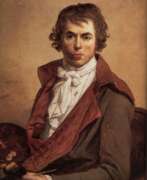

Jacques-Louis David, a preeminent French artist of the Neoclassical movement, made a profound impact on the art world with his compelling history paintings and portraiture. Born in Paris in 1748 into a prosperous family, David's early life was marked by tragedy and ambition. Despite losing his father at a young age and facing opposition from his family, his determination to pursue art led him to become a student of Joseph-Marie Vien and later, a notable figure in the French Academy in Rome. David's artistic journey was characterized by a rigorous classical education, culminating in winning the prestigious Prix de Rome in 1774, which allowed him to study the masterpieces of classical antiquity and the Renaissance in Italy.
David's work is renowned for its classical austerity, a response to the frivolous Rococo style that preceded him. His paintings, such as "The Oath of the Horatii," reflect a blend of classical themes with a modern sense of emotion and drama, resonating with the revolutionary spirit of his times. As the French Revolution unfolded, David aligned himself with its ideals, becoming an active supporter and using his art to serve political purposes. He was closely associated with leaders of the Revolution, including Maximilien Robespierre, and later became the official painter of Napoleon, contributing significantly to the iconography of the era.
Throughout his career, David had a significant influence on French art, not only through his own works but also as a teacher. His studio was a nurturing ground for the next generation of French painters, despite his reputation for being demanding. David's move to Brussels after the fall of Napoleon marked the final phase of his career, where he continued to paint until his death in 1825.
David's legacy extends beyond his contributions to Neoclassical art. He played a crucial role in the development of modern art history, blending classical ideals with contemporary themes, and influencing not only his contemporaries but also future generations of artists. His works, housed in museums around the world, continue to be studied and admired for their technical mastery and emotional depth.
For art collectors and experts, David's oeuvre offers a fascinating insight into a transformative period in art history, where the classical and the contemporary intersected to create a new visual language. His paintings not only depict historical and mythological scenes but also embody the ideals, struggles, and aspirations of his time.
For those interested in exploring the works of Jacques-Louis David and the impact of his art on the Neoclassical movement, updates on new product sales and auction events related to David's work can provide valuable opportunities to engage with his legacy. Signing up for updates ensures access to the latest information and events, offering a deeper understanding of this pivotal artist's contributions to art and culture.


Ludwig Julius Christian Dettmann was a German artist of the late 19th century and the first half of the 20th century. He is known as one of the leading representatives of the Secession in Germany.
Dettmann began his career as an illustrator and in 1895 became a professor at the Berlin Academy of Arts. He then switched to landscape painting, worked in oil and watercolor techniques and became one of the first Impressionists in Germany. In 1898 the artist joined the Association of German Free Artists and co-founded the Berlin Secession. In 1900 Dettmann became director of the Königsberg Academy of Arts and promoted the development of the Nida colony of landscape artists on the Curonian Spit.


Nikolai Dmitrievich Dmitriev-Orenburgsky (Russian: Николай Дмитриевич Дмитриев-Оренбургский) was a Russian painter born in 1837 in Nizhny Novgorod. He is renowned for his battle scenes and depictions of Russian village life. Dmitriev-Orenburgsky studied at the Imperial Academy of Arts in St. Petersburg, where he was part of the ‘revolt of fourteen’—a group of students who challenged the conservative academic traditions of their time.
Dmitriev-Orenburgsky's work often reflected the harsh realities of rural Russian life, with a notable melancholic undertone even in his more cheerful scenes. His involvement in the Russo-Turkish War (1877-78) profoundly influenced his art, leading to several acclaimed battle paintings. Some of his significant works include "General M. D. Skobelev on his Horse" and "Siege of Plevna," which are housed in prestigious collections such as the Hermitage Museum and the Russian Museum.
His genre paintings, like "Sunday in a Village" and "Fire in a Village," capture the essence of Russian peasant life with striking realism and emotional depth. Dmitriev-Orenburgsky's legacy is celebrated for its historical significance and artistic excellence, making his works highly sought after by collectors and exhibited in major galleries worldwide.
Stay informed about upcoming sales and auctions featuring works by Nikolai Dmitrievich Dmitriev-Orenburgsky by signing up for our updates. Subscribe now to receive alerts on new product sales and auction events related to this distinguished artist.


Lewis Carroll, real name Charles Lutwidge Dodgson, was a British writer and photographer, philosopher and logician, and professor of mathematics.
In 1851 Lewis entered one of the best colleges in Oxford - Christ Church. Showing an extraordinary aptitude for mathematics, soon he was able to give lectures himself, and for the next quarter of a century he was a professor of mathematics at Oxford. In parallel with his studies, the young man began to compose short stories and poems, publishing them under a pseudonym.
And then he wrote the famous "Alice's Adventures in Wonderland" (Alice's Adventures in Wonderland, 1865) and "Alice in Looking-Glass" (Through the Looking-Glass, and What Alice Found There, 1871). These books quickly became popular, they were translated into numerous languages, and then repeatedly screened. The prototype of the main character was four-year-old Alice Liddell, the daughter of the new dean of the college where Carroll taught. Lewis Carroll also wrote "The Knotty Story", a humorous poem "Hunting the Snark", "Mathematical Curiosities", "Sylvia and Bruno" and other books. Carroll himself considered his main work a slightly absurd novel-tale "Sylvia and Bruno" (1889-1893).
Under his real name, the writer-mathematician published scientific works on mathematics and logic, he also owns a number of popular books on entertaining mathematics. Lewis Carroll left Oxford only once - in 1867, visiting Russia as part of a delegation of the Anglican Church on the route St. Petersburg-Moscow-Nizhny Novgorod. This was Carroll's only overseas trip, and he described it in his Diary of a Trip to Russia 1867. Lewis Carroll was also a talented chess player and amateur inventor. Photography was also a big part of the writer's life.


Vladimir Nicholaevich Domogatsky (Russian: Владимир Николаевич Домогацкий) was a Russian sculptor, teacher, and Honored Art Worker of the RSFSR, known for his contribution to the development of Soviet sculpture. Born in Odessa in 1876 and spending his early years in Switzerland and Ukraine, Domogatsky's life and career were predominantly centered in Moscow. He studied law at Moscow University and then took up sculpture under the tutelage of S.M. Volnukhin and S.V. Ivanov. Domogatsky's work was greatly influenced by the works of P. P. Trubetskiy, Auguste Rodin, the animalist painter R. Bugatti and others. Travels to Paris and Italy contributed to the improvement of his skills, especially in working with marble.
Domogatsky's work was diverse: genre, animalistic and portrait sculpture. Notable works include Boy in a Coat (1904), Portrait of an Old Actor (1913), and Portrait of Lev Shestov (1917), demonstrating his skill in merging Russian sculptural traditions with Western European influences. Teaching at the Moscow Institute of Fine Arts, organizing and participating in exhibitions all attest to his significant influence on the Soviet art scene. His works are held in prestigious museums, including the State Tretyakov Gallery, reflecting his enduring legacy in Russian art.
For collectors and experts, Domogatsky's sculptures represent a unique combination of historical and cultural narrative, embodied in the subtlety of his craftsmanship. His contributions to monumental propaganda and theoretical developments in sculpture further cement his status as a key figure in 20th century Soviet art.
To keep abreast of exhibitions and auctions featuring works by Vladimir Nikolayevich Domogatsky, we encourage you to subscribe to our updates. By subscribing, you will be the first to know about new sales and auction events related to this esteemed artist and enrich your collection with items of significant historical and artistic value.


Nikolay Nikanorovich Dubovskoy (Russian: Николай Никанорович Дубовской) was a distinguished Russian landscape painter, renowned for his significant contributions to the "Landscape of Mood" movement alongside Isaac Levitan. Born into a Don Cossack family in Novocherkassk in 1859, Dubovskoy demonstrated artistic talent from an early age, initially encouraged by his uncle A.V. Pyshkin. Despite his father's initial insistence on a military career, Dubovskoy pursued his passion for art, studying under Mikhail Clodt at the Imperial Academy of Arts and later refusing a conventional academic path to instead exhibit with the Imperial Society for the Encouragement of the Arts. His work, "Winter," gained him early recognition when acquired by the Tretyakov Gallery in 1884.
Dubovskoy's legacy includes several masterpieces, such as "After the Rain," a beautiful example of his mature period that demonstrates the influence of French Impressionism, with its open composition and luminous treatment of light. This piece and others underline his mastery in capturing the nuanced interplay of light and atmosphere, resonating with both the Impressionist and Itinerant movements. Unfortunately, the distribution of his works across various museums after his death and the Soviet Union's collapse has made accessing his complete oeuvre challenging, requiring a journey across multiple countries.
Dubovskoy's contributions to Russian landscape painting and his unique ability to evoke mood and atmosphere in his works have cemented his place among the greats of the art world. His paintings, such as "The Calm Evening," praised as a "poem in gold" by critics, demonstrate his exceptional skill in rendering the delicate interplay of light and color. For those interested in exploring the depths of Russian landscape painting, Nikolay Nikanorovich Dubovskoy's works offer a rich and emotive experience, embodying the spirit of an era and the beauty of the Russian landscape.
To stay updated on sales and auction events featuring works by Nikolay Nikanorovich Dubovskoy, sign up for our updates. This subscription will ensure you're informed about new opportunities to appreciate and acquire pieces by this illustrious artist, focusing solely on relevant product sales and auction events.


Ivan Osipovich Dudin (Russian: Иван Осипович Дудин) was a Russian and Soviet artist, painter, translator, and educator. He was born on January 19, 1867, in Moscow and passed away on April 4, 1924, in the same city. Dudin received his education at Moscow University and the Moscow School of Painting, Sculpture, and Architecture, where he was awarded the title of class artist in 1902.
Dudin is known for his landscapes, portraits, and genre scenes. His extensive travels influenced his works significantly. Since 1894, he regularly participated in exhibitions of the Moscow Society of Art Lovers and the Association of Traveling Art Exhibitions. Among his notable students were famous artists such as A.V. Kuprin, V.A. Favorsky, and V.I. Mukhina.
One of Dudin's significant works is "Blooming Garden" from 1902, which is exhibited in the State Tretyakov Gallery. His works can also be found in museums in Irkutsk, Kirov, and Krasnodar.
If you want to receive updates on new sales and auction events related to Ivan Osipovich Dudin, sign up for our updates. We will inform you only about new arrivals and events related to this artist.


William Dunlap was an American playwright, theater director, artist, and historian.
William Dunlap was a pioneer of the young country's theater. He directed two of New York City's earliest and most famous theaters, the John Street Theater and the Theater in the Park. During his lifetime he directed over sixty plays, most of which were adaptations or translations of French and German works. But among them were some original ones based on American themes with American characters.
In 1832 Dunlap published A History of the American Theater in two volumes. In 1825, Dunlap co-founded the National Academy of Design and taught at its school. Even today, Dunlap is best known for his encyclopedic three-volume History of the Origin and Progress of the Art of Design in the United States. The book was published in 1834 and is now an invaluable source of information about artists, collecting, and artistic endeavors in the country of that historical period.


Timothy Dwight IV was an American clergyman, teacher, author, and satirical poet.
Dwight was the eldest son of farmer and merchant Timothy Dwight III. He graduated from Yale University, was a schoolmaster, a Massachusetts state legislator, and a chaplain in the Continental Army. In 1783 he opened a successful school in Greenfield Hill, Connecticut, where he became pastor of the Congregational Church.
In Connecticut, Dwight began writing poetry, such as Greenfield Hill (1794), and epics, including The Conquest of Canaan (1785), an allegory of the conquest of Connecticut from the British. His works are characterized by moralizing and moralizing. Dwight was also the author of political satire, as well as a verse satire on Voltaire, "The Triumph of Infidelity." He and his brother Theodore were members of a group of writers known as the Hartford Witters, centered around Yale University.
From 1795 to 1817. Dwight served as president of Yale University and was extremely influential in modernizing the curriculum. He was an active and eloquent professor of theology; his sermons were published in Theology; Explanation and Defense, 5 volumes (1818-19).
Dwight was also a member of the American Academy of Arts and Sciences and an early member of the American Antiquarian Society.


Grigory Kononovich Dyadchenko (Russian: Григорий Кононович Дядченко) was a Ukrainian artist and educator, born on October 8, 1869, in Kirilovka. Known for his landscape and portrait paintings, Dyadchenko's work embodies the realism movement. He studied at the Kyiv Drawing School and later graduated from the Imperial Academy of Arts in St. Petersburg, where he earned multiple awards.
Dyadchenko's artistry is evident in his poetic landscapes such as "Evening on the Dnieper" and "Kiev. View of Podil," which are characterized by their atmospheric depth and emotional resonance. His portraits, including "Head of a Girl" and the depiction of sculptor F. Balavensky, are celebrated for their psychological insight.
Dyadchenko also contributed to art education by teaching at the Kyiv Drawing School, influencing future artists like Mykhailo Kozyk and Vasyl Sylvestrov. His works are preserved in the National Art Museum of Ukraine and other prominent collections.
For those interested in Dyadchenko's art, sign up for updates on new product sales and auction events related to his masterpieces.


Thomas Cowperthwait Eakins was a pivotal figure in American realism, celebrated for his profound and uncompromising portrayal of the human figure. Born on July 25, 1844, in Philadelphia, Pennsylvania, Eakins dedicated his life to depicting authentic human experiences and emotions through painting, sculpture, and photography.
Eakins' education in art began at the Pennsylvania Academy of the Fine Arts and extended to studying abroad in Europe, where he was influenced by French realists and the anatomical precision in their work. His approach combined rigorous study of the human form with a realistic portrayal of American life, making significant contributions to both art and educational practices in the United States.
His notable works include "The Gross Clinic" and "Max Schmitt in a Single Scull," which showcase his mastery in combining technical skill with emotional depth. These pieces not only depict scenes from everyday life but also incorporate a level of detail that reveals Eakins' deep respect for the individuality and inner life of his subjects. Despite facing criticism during his lifetime, particularly for his unflinching realism and subjects considered controversial at the time, Eakins was posthumously recognized as one of America's foremost painters.
For those interested in learning more about Thomas Cowperthwait Eakins' life, works, and his impact on American art, visiting collections that feature his work, such as the Metropolitan Museum of Art and the Pennsylvania Academy of the Fine Arts, can offer deeper insights.
To stay updated on exhibitions, new findings, and auction events related to the remarkable works of Thomas Cowperthwait Eakins, consider signing up for our newsletter. Gain exclusive insights and early notifications tailored for collectors and art enthusiasts. This is an excellent opportunity to deepen your appreciation and knowledge of one of America's greatest realist artists. Subscribe today to ensure you don't miss out on these valuable updates!


Johann Leberecht Eggink (Russian: Иван Егорович Эггинк) was a German-Baltic and Russian artist of the first half of the 19th century. He is known as a painter and teacher.
Johann Eggink lived and worked in the Russian Empire for some 40 years. He was mainly engaged in historical painting, creating paintings with subjects from a variety of eras, including ancient Rome and ancient Russia. The artist was also famous for his portraits and portrait miniatures. He received the title of Academician of the Imperial Academy of Arts in St. Petersburg.


Wilhelm Heinrich Ernst Eitner was a German painter of the late nineteenth and first half of the twentieth centuries. He is known as an impressionist painter and teacher.
Eitner produced portraits, landscapes, and woodcuts in a style reminiscent of Japanese art. Despite initial rejection in German society of his impressionist style of painting, over the years he gained recognition and even the title "Claude Monet of the North." Eitner was a member of numerous art associations. His works are preserved in the Hamburg Kunsthalle.


Edward William Elgar (Sir Edward William Elgar, 1st Baronet) was a British composer of the Romantic period.
The son of an organist, Elgar was a fine violinist, played the bassoon, and worked as a Kapellmeister and church organist. Then in Malvern, Worcestershire, he began composing music himself. He composed several major choral works, notably the oratorio The Light of Life (Lux Christi (1896,), and in 1898-99 he wrote the popular Enigma Variations for orchestra. Another major work followed in 1900, the oratorio The Dream of Gerontius, which is considered his masterpiece.
From 1905 to 1908 Elgar was the first Professor of Music at the University of Birmingham. During World War I, he periodically wrote patriotic works. His marches, introductions, symphonies, and concertos for strings are well known. Elgar's vibrant works contributed to the revival of English music in the 20th century during the transition from late Romanticism.
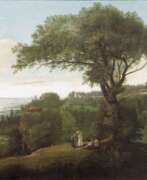

Yermolai Ivanovich Esakov (Russian: Ермолай Иванович Есаков) was a Russian painter, renowned for his landscape and battle scenes. Born in 1790, Esakov studied at the Imperial Academy of Arts under M. M. Ivanov and graduated in 1809. He gained recognition for his painting "Waterfall in a Mountainous Area," which earned him a gold medal and a position as a pensioner at the Academy.
Esakov worked as a domestic artist for the Stroganov family from 1810 to 1824. During this period, he accompanied Count P. A. Stroganov to Moldova during the Russo-Turkish War, where he painted "Russian Camp near Silistra." This work earned him the title of Academician at the Imperial Academy of Arts.
Esakov's paintings are characterized by their detailed representation of nature and historical events, showcasing his skill in capturing both the serene and the dramatic. His works are housed in various Russian museums, continuing to attract art lovers and collectors.
Stay informed about new product sales and auction events related to Yermolai Ivanovich Esakov by signing up for our updates.


Michael Faraday was a British physicist and chemist, explorer and experimenter.
Faraday, because of his family's poverty, was unable to receive a formal education, but at the bookbinding shop in London where he worked, he read many books, including encyclopedias and textbooks on chemistry and physics. He persevered in self-education, attending hearings at the City Philosophical Society and later lectures by Sir Humphry Davy at the Royal Institution, who as a result took the able student on as an apprentice. In 1825 he replaced the seriously ill Davy in the management of the laboratory of the Royal Institution.
In 1833 Faraday was appointed to a research chair of chemistry created especially for him, where, among other achievements, the scientist liquefied various gases, including chlorine and carbon dioxide. His study of heating and lighting oils led to the discovery of benzene and other hydrocarbons, and he experimented extensively with various steel alloys and optical glasses. Faraday was an excellent experimentalist who presented his ideas in simple language. He is best known for his contributions to the understanding of electricity and electrochemistry. The concepts behind electromagnetic induction, diamagnetism, and electrolysis were some of his most important discoveries. His electromagnetic research formed the basis of the electromagnetic equations that James Clerk Maxwell developed in the 1850s and 1860s.
Between 1831 and 1855, Faraday read a series of 30 papers before the Royal Society, which were published in his three-volume Experimental Investigations in Electricity. His bibliography numbers some 500 printed articles. By 1844 he had been elected a member of some 70 scientific societies, including the St. Petersburg Academy of Sciences.


Eleanor Fortescue-Brickdale was a British Pre-Raphaelite painter, illustrator and stained glass artist.
At the age of 17, she enrolled at Crystal Palace School of Art and was later admitted to the Royal Academy of London and she initially worked with illustration. In 1897, Eleanor won a prize for her painting "Spring", which allowed her to begin work on her first large-scale oil painting, "The Pale Color of True Love". The painting was exhibited at the Royal Academy in 1899.
In 1902 Eleanor Fortescue-Brickdale was elected the first female member of the Institute of Oil Painters. She illustrated many books, including Tennyson's Royal Idylls in 1911. She taught at the Byam Shaw School of Art in Kensington. During the First World War, the artist designed posters for government departments and later several commemorative stained glass windows and a memorial in York Cathedral. In 1919 she became a member of the Royal Society of Watercolor Painters.


Joseph Fourier, full name Jean-Baptiste Joseph Fourier, was a French mathematician and physicist and historical Egyptologist.
Fourier famously accompanied Napoleon Bonaparte on his Egyptian expedition in 1798 as a scientific advisor and was appointed secretary of the Institute of Egypt. During the occupation of Egypt, Fourier worked in the French administration, supervised archaeological excavations, and worked to shape the educational system.
But the main thing in Fourier's life was science. Back in France, he studied the mathematical theory of heat conduction, established the partial differential equation governing heat diffusion, and solved it using an infinite series of trigonometric functions. Fourier showed that heat diffusion obeyed simple observable physical constants that could be expressed mathematically. His work The Analytic Theory of Heat (1822) had a great influence on the development of physics and pure mathematics.
Joseph Fourier was a member of the Paris Academy of Sciences, the French Academy, a foreign honorary member of the St. Petersburg Academy of Sciences, and a member of the Royal Society of London.


Jean-Baptiste Fresez was a German painter of French origin.
He began his studies at the Luxembourg School of Drawing and then continued at the Royal Academy in Brussels and obtained Luxembourg citizenship. Fresez worked as an engraver and painter at the Villeroy and Boch porcelain factory in Mettlach on the Saar River, and from 1824 he successfully taught at the Luxembourg Drawing School.
Fresez produced beautiful landscapes and very lively portraits. These are mainly of members of the Grand Ducal family and other well-known local personalities. A collection of 30 lithographs was published based on his landscape drawings, which today are considered very valuable in documentary terms, and each of them has a detailed description. Fresez's landscapes are characterized by their almost photographic depictions of the city of Luxembourg. After the publication of this work, he was elected a member of the Archaeological Society of the Grand Duchy.


Alexander Fedorovich Gaush (Russian: Александр Фёдорович Гауш), born in 1873 and passing away in 1947, was a distinguished Russian painter whose contributions to art spanned various genres and styles, with a particular emphasis on landscape and still life paintings. His education under the tutelage of prominent artists like P. P. Chistyakov and at the St. Petersburg Academy of Arts, as well as his time at the Académie Julian in Paris, played a significant role in shaping his artistic direction. Gaush's involvement with the "New Society of Artists" and the "World of Art" association highlighted his active engagement with the artistic movements of his time.
Gaush's teaching career in institutions across Petrograd, Sevastopol, and Odessa further underscores his dedication to nurturing the next generation of artists. His works, celebrated for their vivid portrayal of the Russian and Crimean landscapes, are housed in art galleries and museums across Russia, Ukraine, and other countries, testament to his lasting influence and the appreciation of his talent on a global scale.
Collectors and art experts continue to value Gaush's artworks for their historical significance and the unique perspective they offer on the landscapes he depicted. His works, often featured in auctions, reflect not only his skill and versatility but also the rich cultural and artistic heritage of his time.
For enthusiasts keen on exploring Gaush's legacy or adding his works to their collections, staying informed about new sales and auction events is crucial. Signing up for updates related to Alexander Fedorovich Gaush can ensure you don't miss out on the opportunity to own a piece of this illustrious artist's legacy.


Willi Geiger was a German artist of the twentieth century. He is known as a painter, graphic artist, illustrator, exlibrist and teacher, a representative of Expressionism.
From the beginning of his career, Geiger created illustrations for the works of famous authors. In later years he became interested in portrait painting, painting copies of works by Spanish masters, especially El Greco, Velázquez and Goya. Geiger was one of the first modern graphic designers. His son Ruprecht Geiger also became a renowned painter and sculptor.
